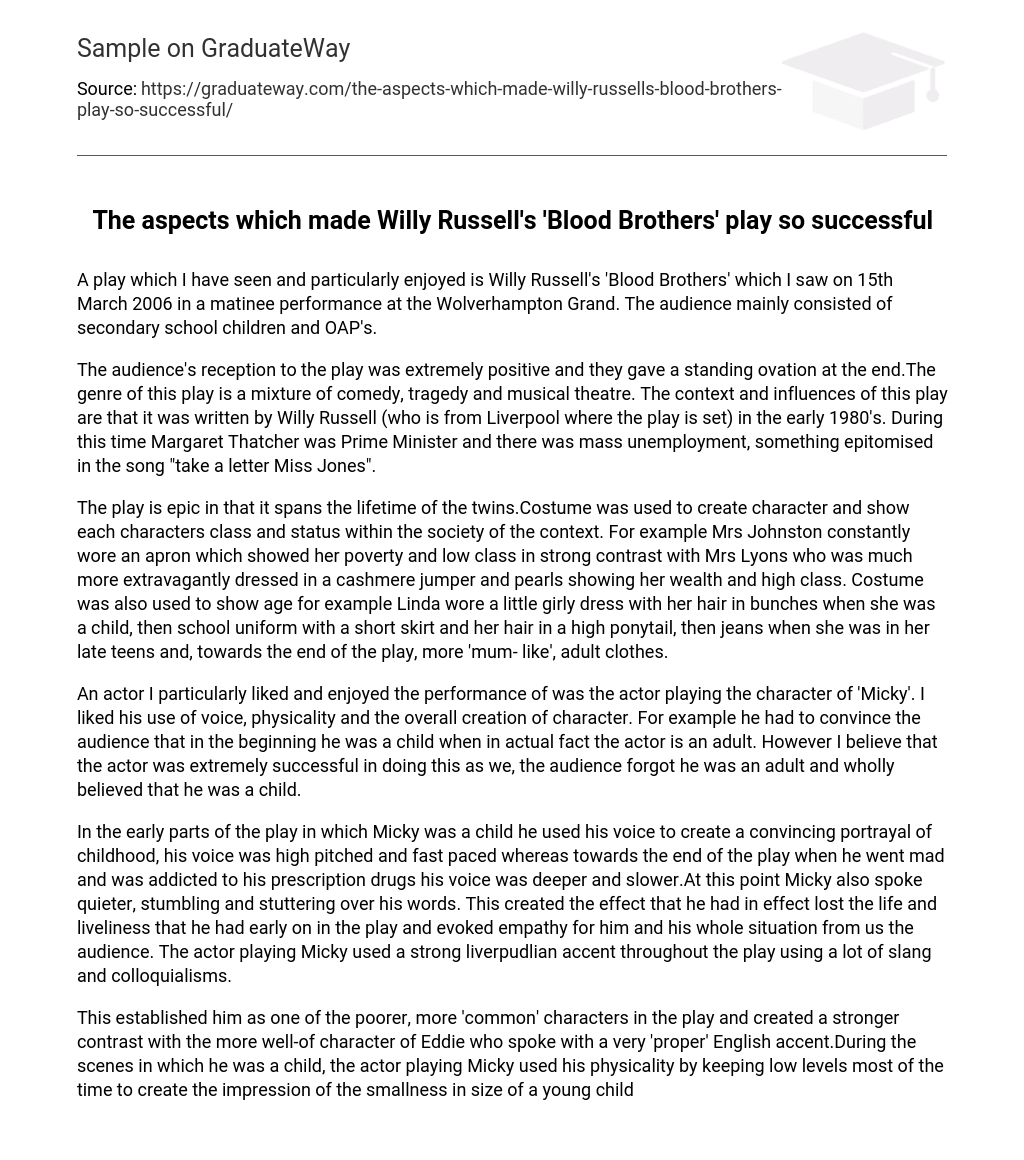A play which I have seen and particularly enjoyed is Willy Russell’s ‘Blood Brothers’ which I saw on 15th March 2006 in a matinee performance at the Wolverhampton Grand. The audience mainly consisted of secondary school children and OAP’s.
The audience’s reception to the play was extremely positive and they gave a standing ovation at the end.The genre of this play is a mixture of comedy, tragedy and musical theatre. The context and influences of this play are that it was written by Willy Russell (who is from Liverpool where the play is set) in the early 1980’s. During this time Margaret Thatcher was Prime Minister and there was mass unemployment, something epitomised in the song “take a letter Miss Jones”.
The play is epic in that it spans the lifetime of the twins.Costume was used to create character and show each characters class and status within the society of the context. For example Mrs Johnston constantly wore an apron which showed her poverty and low class in strong contrast with Mrs Lyons who was much more extravagantly dressed in a cashmere jumper and pearls showing her wealth and high class. Costume was also used to show age for example Linda wore a little girly dress with her hair in bunches when she was a child, then school uniform with a short skirt and her hair in a high ponytail, then jeans when she was in her late teens and, towards the end of the play, more ‘mum- like’, adult clothes.
An actor I particularly liked and enjoyed the performance of was the actor playing the character of ‘Micky’. I liked his use of voice, physicality and the overall creation of character. For example he had to convince the audience that in the beginning he was a child when in actual fact the actor is an adult. However I believe that the actor was extremely successful in doing this as we, the audience forgot he was an adult and wholly believed that he was a child.
In the early parts of the play in which Micky was a child he used his voice to create a convincing portrayal of childhood, his voice was high pitched and fast paced whereas towards the end of the play when he went mad and was addicted to his prescription drugs his voice was deeper and slower.At this point Micky also spoke quieter, stumbling and stuttering over his words. This created the effect that he had in effect lost the life and liveliness that he had early on in the play and evoked empathy for him and his whole situation from us the audience. The actor playing Micky used a strong liverpudlian accent throughout the play using a lot of slang and colloquialisms.
This established him as one of the poorer, more ‘common’ characters in the play and created a stronger contrast with the more well-of character of Eddie who spoke with a very ‘proper’ English accent.During the scenes in which he was a child, the actor playing Micky used his physicality by keeping low levels most of the time to create the impression of the smallness in size of a young child. He also moved around quickly and rarely kept still thus capturing the energy and excitable nature of most young children. Mickey mostly ran, jumped or skipped around the stage rarely walking.
An interesting physical device used by this actor was to mime riding a horse as often children do.I do not know for sure but I would suspect that the actor playing Micky used some of Stanislavski’s rehearsal techniques in order to get into the character and mind of a child and to help him play this role so successfully. For example he could have used ‘imagination’ to imagine what a child would do and how they would feel in the ‘given circumstances’. He may also have used ‘observation’ and by observing children’s behaviour created a memory bank of gestures, actions and physicality to use.
Another technique that this actor likely used is ’emotion memory’ and by remembering how he felt and behaved as a child he could create the character of Micky convincingly.A moment I particularly liked in this play was the end scene where the Brothers have both died and the final song is sung. I think that the use of proxemics in this scene was extremely effective. For instance the two brother’s ‘bodies’ were lying side by side centre stage with Linda crouching at their side and Mrs Johnston standing behind them.
As Mrs Johnston began singing the other characters appeared on stage around the edges and gradually joined in with the song. Mrs Lyons, Eddie’s adopted mother was positioned at the very back underneath the arch. This created a distance with her from the action in strong contrast with Mrs Johnston who was right at the side of both her sons representing her closeness and her bond with them as their birth mother. At this moment Mrs Johnston lifted the hands of both brother’s and placed them together.
This was a key symbolic gesture as it represented the invisible bond between the brothers and even though they were now deed it suggests they are still connected and together in death.At the end of the play the audience experienced a strong feeling of catharsis with many audience members moved to tears. This was down to the convincing portrayal of the characters by the actors throughout the play so that by the time it came to the death of the brothers, the audience felt that they knew the characters and could empathise with them therefore their death was like a loss for the audience and even though we learn at the beginning that the brothers die we still hoped that they didn’t.





